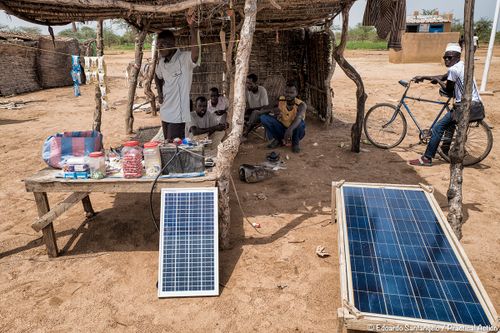Click here to register!
Difference between revisions of "Webinar Series: Sustainable Energy in Humanitarian Settings"
***** (***** | *****) m |
***** (***** | *****) m Tag: 2017 source edit |
||
| Line 15: | Line 15: | ||
</div> | </div> | ||
| − | == | + | == [[Webinar Series on Energy-Livelihoods Nexus in Humanitarian Settings]] == |
| + | {{#widget:YouTube|id=Ydf7PVfw3kc|height=400|width=600}} | ||
| + | {{#widget:YouTube|id=XXhNdEm1bys|height=400|width=600}} | ||
| + | {{#widget:YouTube|id=XGTqStf5dCY|height=400|width=600}} | ||
| − | |||
*[[Webinar Series on Decarbonisation of Energy Infrastructure in Displacement Situations|Webinar Series on Decarbonisation of Energy Infrastructure in Displacement Situations (Sept-Nov 2021)]] | *[[Webinar Series on Decarbonisation of Energy Infrastructure in Displacement Situations|Webinar Series on Decarbonisation of Energy Infrastructure in Displacement Situations (Sept-Nov 2021)]] | ||
*[[Webinar on How to Integrate Renewable Energy Solutions into Humanitarian Response Planning?|How to Integrate Renewable Energy Solutions into Humanitarian Response Planning? (Sept 2021)]] | *[[Webinar on How to Integrate Renewable Energy Solutions into Humanitarian Response Planning?|How to Integrate Renewable Energy Solutions into Humanitarian Response Planning? (Sept 2021)]] | ||
Revision as of 13:53, 29 August 2022
Webinar Series Sustainable Energy in Humanitarian Settings

Today, over 130 million people are in need of humanitarian assistance due to conflict, natural disasters, and other complex global challenges. For many of these people, access to energy sources is critical for survival, and how they access it impacts their health, livelihoods, safety, and well-being.
Energy access for displaced people is not prioritized in the global humanitarian system. Current energy practices in situations of displacement are often inefficient, polluting, unsafe for users, and harmful to the surrounding environment. Moreover, institutional humanitarian operations such as water pumping, community lighting, and health clinics rely heavily on unsustainable fossil fuels, costing hundreds of millions of dollars annually.
Given the complex nature of humanitarian response and the challenges of integrating sustainable energy solutions into the humanitarian program cycle, there is not just one solution but a need for systemic actions to mobilise resources, build capacity and use the opportunity for sustainable energy solutions to enhance impact in sectors such as health, protection, food security, and WASH. read more
Against this background, key actors involved in displacement settings developed in 2018 the Global Plan of Action for Sustainable Energy Solutions in Situations of Displacement (GPA). It’s mission is to equip stakeholders with the capacity to mainstream sustainable energy solutions into programming, with the goal of delivering improved protection, dignity, and energy-related social, environmental, and economic benefits to displaced people.
As part of the outreach and capacity building activities of this movement, the International Committee of the Red Cross (ICRC) together with the Steering Group of the GPA and other partners are conducting a series of webinars on humanitarian energy issues to raise awareness and spread knowledge about different technologies, best practices and impacts.
Webinar Series on Energy-Livelihoods Nexus in Humanitarian Settings
- Webinar Series on Decarbonisation of Energy Infrastructure in Displacement Situations (Sept-Nov 2021)
- How to Integrate Renewable Energy Solutions into Humanitarian Response Planning? (Sept 2021)
- Landscaping : Capacity Building and Knowledge Sharing Opportunities (Feb 2021)
- Productive Uses of Energy in Humanitarian Contexts (Oct 2020)
- Powering Possibilities : Lessons Learned from Mini-grid Application in Conflict and Fragile Contexts (Sep 2020)
- Powering WASH : Renewable Energy for Water Supply in Humanitarian Settings (June 2020)
- Powering Humanitarian Health Operations : Sustainable Energy Solutions (May 2020)
- Energy Efficiency and Designing for Sustainability in Humanitarian Response (Feb 2020)
- Powering Humanitarian Facilities : Dialogue on Implementation Models (Jan 2020)
- Sustainable Energy for Household Cooking Needs in Humanitarian Settings (Dec 2019)
- Sustainable Energy for Powering Household and Community Lighting Needs in Humanitarian Settings (Nov 2019)
- Sustainable Energy for Essential Humanitarian Services : Outline of Energy Solutions and a Case Study on Solar Pumping (Sep 2019)
- State of Play : Sustainable Energy in Humanitarian Settings (June 2019)
Further Resources on Humanitarian Energy
Find here some useful resources for further information:
Available resources on energypedia
Global Plan of Action
- Global Plan of Action - Framework for Action
- Global Plan of Action - Unitar website
- Identification And Analysis Of Standard Clauses Of PPA And Leasing Agreements For Energy Provision In The Humanitarian Sector
- Feasibility and Applicability of a Global Guarantee Mechanism in Humanitarian Energy Contracts
- SAFE Workshop 2019 - Final Report
- Humanitarian Energy Conference 2019 - Final Report
- Renewable Electrification of Refugee Camps – Phase 1
Mercy Corps
Moving Energy Initiative
- The Costs of Fuelling Humanitarian Aid (2018)
- The Solar Energy Handbook - A guide to institutional solar for organizations working in humanitarian settings
- Private-Sector Engagement - The Key to Efficient, Effective Energy Access for Refugees. Toolkit (2016)
- Heat, Light and Power for Refugees Saving Lives, Reducing Costs (2015)
- Prices, Products and Priorities - Meeting Refugees’ Energy Needs in Burkina Faso and Kenya (2018)
Renewable Energy Transition
- McKinsey (2019): Energy Perspective 2019: Reference Case
- World Economic Forum (2019): Fostering Effective Energy Transition 2019
- World Economic Forum Website: Shaping the Future of Energy
Grantham Instittute
Blog Articles
- Rachel Kyte: https://www.seforall.org/news/on-world-humanitarian-day-its-time-we-finally-talk-about-energy-access
- Vijay Bhopal and Sandy Robinson: Is Sustainable Attainable?




















